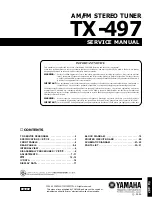
Ten-Tec 238C manual
Part #74428
First release, June 2009. Printed in U.S.A.
or less of transmitter power and note SWR
shown on the meter. Depending on which of
the HIGH Z 1 or LOW Z 1 settings showed a
lower SWR, try more positions on the same
side to see if the SWR is lower. Choose the
position among all switch positions that
shows lowest SWR.
Adjust the capacitor for lowest SWR. Then
turn the roller inductor clockwise to a higher
setting and note if SWR changes. If SWR
drops, adjust the capacitor for a lower SWR
value. Go back and forth between these two
controls, adjusting them for best match and
the lowest available SWR.
If the capacitor shows best meter null
(lowest SWR) at a setting of ‘0’, turn the
center switch to the other side of BYPASS.
If the best meter null (lowest SWR) is with
the capacitor at ‘10’, turn the center switch
to the next higher position.
It is possible depending on your antenna
and the frequency in use that a good
‘starting’ match may not be readily apparent
(i.e. all starting positions on the center
switch show a somewhat high SWR). Try
adjusting the roller inductor and/or capacitor
to a higher initial setting and repeat the
same instructions if this is the case.
WARNING:
While all the components of the
238C are rated to easily handle continuous
duty operation at full rated power, do NOT
adjust the antenna tuner when running high
output power. Adjust the tuner for lowest
SWR at less that 50 watts, and then enable
your linear amplifier. High circulating
currents are present when high power is
applied to the tuner; adjusting the tuner
controls for lower SWR while running high
power through the tuner can damage the
unit.
WARNING:
In normal operation, the 238C
produces very high RF voltages and
currents. We do not recommend operation
of this tuner without the top cover securely
installed due to the danger of contact with
high voltage.
WARNING:
Always be sure that a dummy
load or antenna is properly connected when
power is applied. Voltages in excess of
ratings can occur if no load is connected.
BALANCED LINE OPERATION NOTE
When using balanced line, if the SWR rises
during a long transmission it is an indication
that a significant portion of the transmitter
power is being lost in the balun. This will be
the case when the antenna impedance is
greater than 500 ohms. Changing the
length of the antenna and/or feedline will
usually cure this problem. Also be aware
(as noted elsewhere in this manual and on
the rear panel of the 238C) that a jumper
must be connected between one of the
balanced line terminals and the SINGLE
WIRE terminal on the rear of the 238C
before balanced line is used. A jumper
attached to one wing nut connector on the
rear panel has been provided for this
application.
160 METER OPERATION NOTE
Some low impedance antenna loads on 160
meters may require more capacitance than
the 2400 pF available with the variable
tuning capacitor at full mesh and the center
switch at position 5 on the LOW Z side
(example: tuning a shortened whip antenna
on 160). If such a condition exists, adding
additional capacitance across the variable
capacitor will usually produce a better
match. A low loss ceramic or mica
transmitting capacitor should be used.
A ceramic capacitor, Ten-Tec part #23160,
1000 pF, 1 kV, is included in the model
238C packing kit for your use. If needed,
install the capacitor by connecting it
between the two EXTERNAL CAPACITOR
wing nuts located vertically on the rear
panel. Most antenna installations will have
no need to install this capacitor.
ANTENNA SYSTEMS MATCHING
THEORY
Most transmitters are designed to work into
a 50 ohm resistive load, and they are not
able to effectively supply RF power to loads
that depart far from this value. However,
many antenna systems, which include the
antenna and the transmission line have
complex impedances that make it difficult, if
not impossible, to load the transmitter
properly. These impedances are a function
of the operating frequency, type of antenna,




























